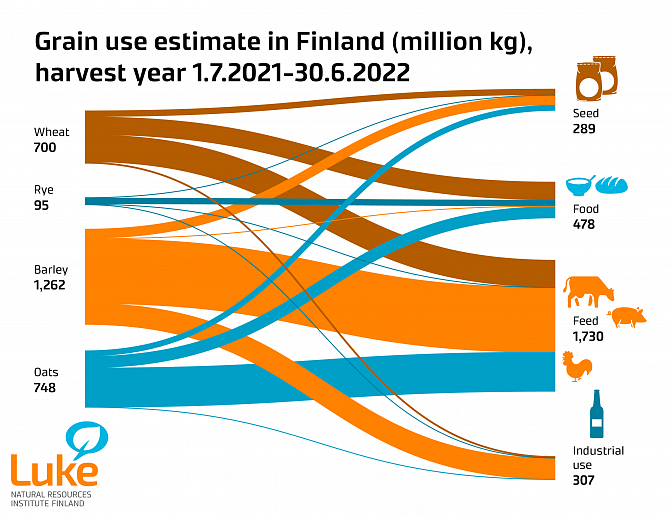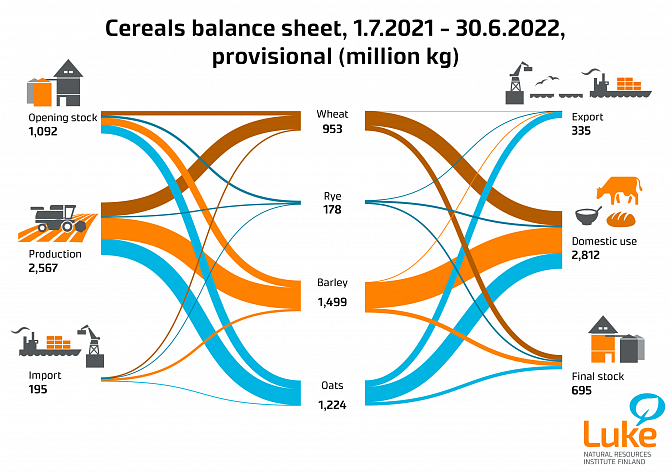Last year’s low cereal harvest was used effectively – Finland’s cereal stocks decreased
As a result of the low cereal harvest in 2021, farms started to use cereal-based feed more diligently. Barley was especially scarce, as experienced most drastically by farms in their daily activities. At the same time, the use of cereals in food production started to increase. This autumn’s harvesting is at its busiest, and the harvest is expected to be higher than last autumn. The figures are based on the Natural Resources Institute Finland’s (Luke) statistics on cereals balance sheet and statistics on the use of harvests on farms.

How did we survive the scarcity of barley?
The 2021 cereal harvest totalled 2.6 million tons, being a quarter lower than the ten-year average. Barley is the most widely cultivated cereal in Finland, and its harvest was as much as a third, or roughly half a million tons, lower than average. The harvest was barely higher than a million tons. The majority of the harvest was consumed on farms for feeding animals.
As a result of the lower harvest, farms used cereal-based feed more diligently, and cereal stocks also decreased. Some 115,000 tons of barley were also imported into Finland. Foreign trade in barley has usually flown in the other direction, as the barley harvest is normally higher than our consumption.
The use of cereals in food production started to increase – approaching 500,000 tons
Domestic mills have for decades ground a little more than 400,000 tos of cereals for use in food production each year. During the last couple of years, the use of cereals in food production has been increasing, being more than 470,000 tons during the 2021–2022 harvest year. This trend has been driven by oats, as its grinding for food production passed rye during the 2016–2017 harvest year. Of the 2021 oat harvest, more than 150,000 tons were already consumed by the mill industry. Instead, the use of rye has shown a slight downward trend, being approximately 80 million kilos during the previous harvest season. However, the wheat production volume is higher than that of other cereals, with some 230,000 tons of wheat being used for production during the previous harvest year.


Oat exports going strong
Finnish oats have claimed their place internationally, and more than 300,000 tons of the 2021 oat harvest of nearly 800,000 tons were exported. This is a fairly ordinary volume. Oat exports from Finland were the highest in 2019 at more than 430,000 tons.
Cereal stocks fell to a minimum
Statistics monitor cereal stocks on farms and in industry and trade. According to estimates, their combined cereal stocks decreased by nearly 400,000 tons from June 2021 to June 2022.
The low harvest in 2021 reduced farms’ cereal stocks to a minimum before the new harvest. As a result, barley and oat stocks are estimated to have decreased by some 150,000 tons from the previous year. Stockpiles in the cereal-using industries were at their lowest in more than a decade.
Background to the statistics
Luke’s Statistical Services monitors the production, use, consumption and stocks of domestic cereals on the basis of available statistical data. The cereal balance sheet and statistics on the use of harvests on farms are prepared every crop year. The most recent statistics are estimates prepared for the crop year from 1 July 2021 to 30 June 2022. Statistical data are available on Luke’s website at luke.fi/en/statistics. The Finnish Cereal Committee also monitors the status of the current crop year (1 July 2022 – 30 June 2023) on a quarterly basis on its website. On 23 September, Luke will publish harvest estimate statistics, representing the harvest outlook as of 19 September 2022.





